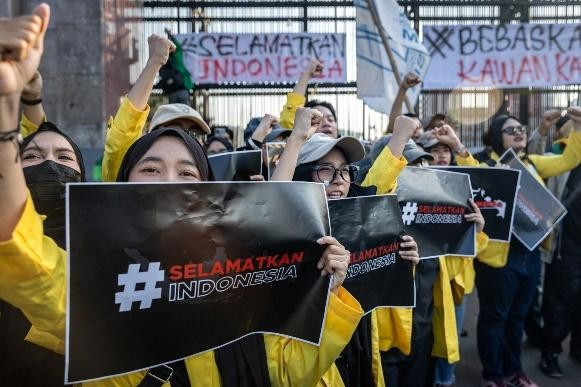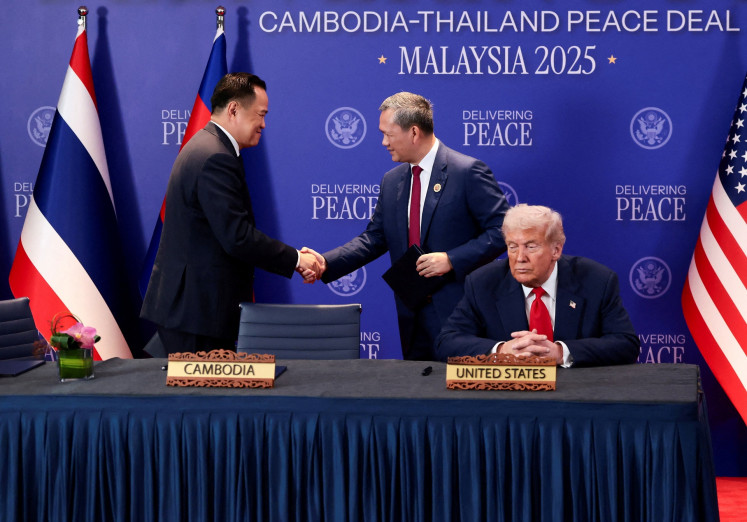Popular Reads
Top Results
Can't find what you're looking for?
View all search resultsPopular Reads
Top Results
Can't find what you're looking for?
View all search resultsAs Trump pivots US from Asia, will China fill void?
With the United States under President elect Trump turning inward and abandoning the Asia-Pacific region by scrapping the Trans-Pacific Partnership (TPP), countries in the Asia-Pacific Rim are scrambling to find an alternative free trade agreement.
Change text size
Gift Premium Articles
to Anyone
 A band conductor leads a military band as China's top leaders arrive for a commemorative meeting held to mark the 150th anniversary of the birth of Dr. Sun Yat-sen, founding father of the Republic of China and founder of the Chinese National Party (KMT) at the Great Hall of the People in Beijing, China, Friday, Nov. 11, 2016. (AP/Ng Han Guan)
A band conductor leads a military band as China's top leaders arrive for a commemorative meeting held to mark the 150th anniversary of the birth of Dr. Sun Yat-sen, founding father of the Republic of China and founder of the Chinese National Party (KMT) at the Great Hall of the People in Beijing, China, Friday, Nov. 11, 2016. (AP/Ng Han Guan)
W
ith the United States under Presidentelect Trump turning inward and abandoning the Asia-Pacific region by scrapping the Trans-Pacific Partnership (TPP), countries in the Asia-Pacific Rim are scrambling to find an alternative free trade agreement.
On his campaign trail, Donald Trump has said that the TPP was a “horrible trade deal”, and that he would pull out the US from the TPP on day one of his presidency.
The TPP was a trade pact supported by President Barack Obama encompassing 12 countries in the Asia-Pacific Rim, excluding China.
Like other free trade pacts, the TPP was believed to be a provider of economic growth, higher income and prosperity to the people of its member countries.
It is a trade pact that goes beyond the business of cutting the tariff and non-tariff barrier. It was meant to be an advanced free trade agreement that would set the standard norms for other free trade pacts by expanding its coverage into the environment, intellectual property rights and labor conditions.
Countries that were involved in TPP negotiations are now looking at China’s backed Regional Comprehensive Economic Partnership (RCEP), whose members consist of 10 ASEAN countries plus China, India, Japan, South Korea, Australia and New Zealand.
The RCEP, which is still being negotiated by the 16 member countries, would be the logical alternative to the TPP as the most important free trade agreement in the Asia-Pacific region, considering its size of combined GDP, trade volume and population.
Leaders of some member countries including Japanese Prime Minister Shinzo Abe have acknowledged that the vacuum left by the death of TPP would most likely be filled by the RCEP.
Despite the goodwill shown by many countries in the public eye, behind the scenes the negotiations are on the verge of falling apart due to serious disagreements over one of the key aspects of the RCEP’s tariff liberalization.
ASEAN, Japan and Australia are hoping for massive tariff reductions across the board but are resisted by China, who insisted on a selective tariff reduction based on each country’s pre-existing free trade agreements.
This means that China is not yet willing to open its economy widely to other country’s products.
Some countries have had painful experiences from its trade with China. Brazil, whose economy depends on its export of natural resources to China, slipped into recession when China’s economy slowed down and commodity prices collapsed.
Indonesia’s fate was slightly better than Brazil as it only experienced slower growth when the commodity export boom from China ended in 2014.
Yet Indonesia’s trade deficit with China has been deteriorating since 2010. The trade deficit stood at US$5.6 billion in 2010, but it ballooned to $16 billion in 2015.
So rapid was the widening of the deficit that the amount in 2015 itself was twice the amount in 2013.
While prices of Indonesian coal, nickel and other commodities fell, prices of Chinese manufactured products entering Indonesia did not. Goods from China — steel, machineries, electronics, smart phones, toys — are still flooding the Indonesian market, giving hard times for Indonesian producers.
Meanwhile the Indonesian government is trying to make up the losses from trade by attracting more investment from China.
A dramatic jump in China’s direct investment in Indonesia occurred this year. Up to September 2016, Foreign Direct Investment (FDI) from China has reached $1.6 billion, almost three times its investment for the whole 2015. Its share of total FDI jumped from 2.1 percent to 7.4 percent.
Most of the Chinese investment is in the mineral and energy sectors. The FDI from China will accelerate as the Indonesian government has taken concerted steps to lure investors from China including setting up a special “China desk” at the office of Investment Coordinating Board (BKPM) in Jakarta.
A second problem comes from China’s overcapacity in the manufacturing base. Negotiators have lamented the possibility that China would use the RCEP to dump its excess steel in member countries that will distort trade.
That would not be surprising since over the last few years, China’s supply of cheap steel has put steel industries in Southeast Asia on the defensive.
In Indonesia, cheap steel imports from China are giving hard times to PT Krakatau Steel and other domestic steel producers.
With the import tariff falling as a result of the RCEP but without tariff reciprocity from Beijing, these steel industries are at risk of going belly up altogether.
There is another venue where China’s increasing role would be more felt in the region. In October 2014 China took the initiative with 20 other countries to establish the Asia Infrastructure Investment Bank (AIIB), which specializes in financing infrastructure projects in Asia. This project was opposed by the US as it competed with other development banks such as the Asian Development Bank (ADB) and the World Bank.
China could use the new bank to expand its influence in Asia at the expense of the US and Japan. China’s decision to finance a new multilateral bank rather than give more to the existing one reflected its exasperation with the glacial space of global economic governance reform.
Although China is the biggest economy in Asia, the Manila based ADB is dominated by Japan. Japan’s voting share is more than twice than that of China’s; reform to have more say for China in the International Monetary Fund (IMF) has been delayed for many years. China is understandably impatient for change.
It is therefore taking matters into its own hands. Indonesia could benefit from this bank as the AIIB could be used as an additional source of funding for its huge planned infrastructure projects.
Through the RCEP and the AIIB, China could exercise its undisputed leadership role in economic issues for the Asia-Pacific region.
But once China takes the mantle of leadership, it is expected to be more concessionary and less protectionist in its trade with countries participating in the RCEP.
China should be more receptive to criticism of its lopsided trade surpluses if it is serious about taking over the leadership role in the Asia-Pacific region.
---------------
We are looking for information, opinions, and in-depth analysis from experts or scholars in a variety of fields. We choose articles based on facts or opinions about general news, as well as quality analysis and commentary about Indonesia or international events. Send your piece to community@jakpost.com. For more information click here.









